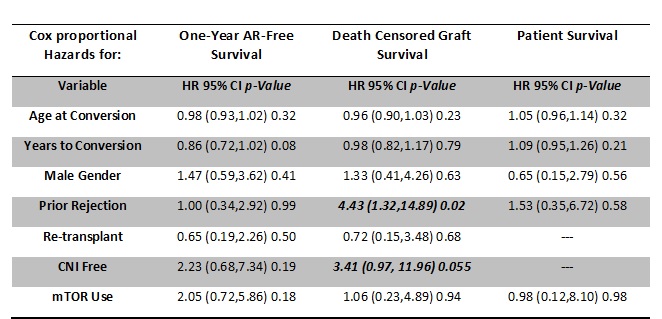Outcomes of Enteric Conversion of Bladder Drained Pancreas; Over a Decade of Experience at a Single Center
Samy Riad MD, MS1, Scott Jackson MS3, Daniel Keys MD1, Danielle Berglund BS3, Viral Vakil MD1, Arthur J Matas MD2, Raja Kandaswamy MD2.
1Division of Nephrology and Hypertension, University of Minnesota , Minneapolis , MN, United States; 2Transplantation , University of Minnesota , Minneapolis , MN, United States; 3Informatics Services for Research and Reporting , Fairview , Minneapolis , MN, United States
Background: Bladder drainage in pancreas transplantation has been used to enable monitoring of urinary amylase allowing for early detection of rejection. The application of this technique has declined due to concern over complications such as severe dehydration, acidosis, hemorrhagic cystitis, recurrent urinary infections and calculi necessitating enteric conversion in up to 30% of patients. We sought to study the outcome of enteric conversion and its impact on the pancreas graft and kidney function.
Methods: We analyzed 177 pancreas transplants (PTA 138, PAK 10 and SPK 39) who underwent enteric conversion between 2003 and 2016. Kaplan-Meier curves and Cox proportional hazards models were used to assess rates of acute rejection-free survival, death-censored graft survival and patient survival within one year of conversion, and the predictors of these outcomes respectively. A paired t-test was used to compare the change in creatinine before and after conversion for non-dialysis recipients.
Results: The probabilities of acute rejection-free survival, death-censored graft survival and patient survival were 87.7%, 92.4% and 95.4% at one year respectively. In the Cox proportional hazards model, acute rejection prior to conversion was associated with a more than four-fold increase in the risk of death-censored graft loss- HR 4.43 (95% CI 1.32, 14.89), p 0.02. CNI-Free maintenance showed a trend toward increased risk of death-censored graft loss – HR 3.41 (0.97, 11.96) p 0.055. The mean creatinine after conversion remained clinically stable although statistically decreased -0.08 mg/dL (95% CI -0.16, -0.01) p 0.036. No independent predictors of survival or acute rejection were identified in our models; it should be noted that a reduced model was used for survival due to a relative lack of events.
Conclusion: Enteric conversion of the bladder-drained pancreas is a relatively safe procedure and well tolerated. Kidney function remained clinically stable after conversion. History of prior rejection episodes was associated with increased graft loss.


